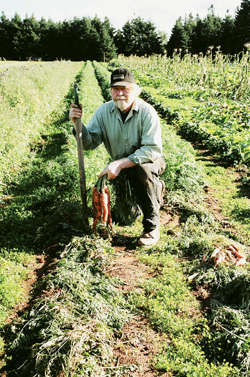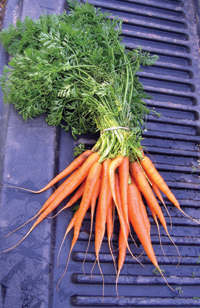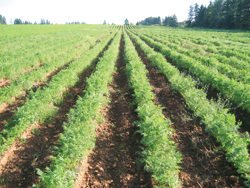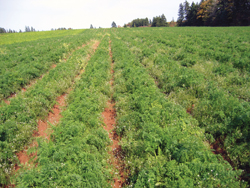
Features
Production
Research
Exploring carrot production without chemicals
Growing carrots without chemicals and using green manure
March 27, 2008 By Kathy Birt
Growing carrots without chemicals
and using green manure for organic matter are experiments being put
into practice by at least two growers on Prince Edward Island.
 |
| Gary Clausheide of Sweet Clover Farm in Valleyfield, Prince Edward Island, checks out his carrot crop for growth at harvest time. With just 0.25 of an acre, the organic grower digs all carrots with a shovel. Photo by Kathy Birt |
Growing carrots without chemicals and using green manure for organic matter are experiments being put into practice by at least two growers on Prince Edward Island.
Sweet Clover Farms and Brookfield Gardens differ in many ways. Sweet Clover is a small, organic farm located near Valleyfield that is owned by Gary Claushiede.
Clausheide plants bluegrass and white clover between his rows of carrots to protect the land from erosion and to have these grasses act as a cover crop for the soil throughout the winter.
The organic grower says he started out using annual rye grass and crimson clover, but found they suffered from winterkill. “I’m trying to develop a system that is sustainable,” explains Clausheide. “About four years ago, I decided to use perennials.”
By inter-seeding between the 20-inch carrot rows about a month after planting the crop, the organic farmer can have the rows filled with bluegrass and white clover by mid-September. “I’ve seen that this inter-planting is not suppressing my crops; I know it’s erosion control and it’s also green manure that I can plow down in the spring,” says Clausheide,who notes that he leaves the carrot tops also to fertilize the soil.
 |
| A sampling of the carrots grown in the AAFC’s organic production test plots, based at Brookfield Gardens. Photo by Basil Dickson, AAFC |
In the spring, he seeds down last year’s vegetable rows with bluegrass and white clover, while the new crop of carrots is planted in the rows that have been “fed” all winter by this green manure.
“Green manure is the crop you grow to feed your soil,” he says, adding that in order to have a healthy soil, it has to be fed. In fact, Clausheide, who has worked at and thought through his theory of using perennials as cover crops, says any organic matter, such as carrot tops, put back into the soil is natural fertility.
Initially, he followed the idea of using annuals as cover crops from Eliot Coleman, who wrote of the idea in the book: The New Organic Grower. “But I don’t know anybody who is using perennials,” he admits.
The theory will take time to test completely and Clausheide does not recommend it to conventional growers. “Farmers, for the most part, can’t take chances. They have to make a living and I fully understand why they resorted to chemicals,” he says, adding he does not think critically about individual farmers not being willing to gamble on organic techniques. “Organic agriculture doesn’t have a solution to every problem.”
Brothers Gerald and Eddy Dykerman, who own Brookfield Gardens near the community of Brookfield, Prince Edward Island, are also experimenting with the organic idea and have grown 150 acres of carrots conventionally for more than 15 years.
 |
| A photo of the Brookfield Gardens’ carrot plot, taken on Sept. 15, 2006. Photo by Basil Dickson, AAFC |
 |
| A photo of the same carrot plot, taken on Oct. 4, 2006. Photo by Basil Dickson, AAFC |
“We are responding to market demand and taking a glimpse at organic,” says Eddy Dykerman.
Last year, the vegetable growers worked with Kevin Sanderson, a research scientist with Agriculture and Agri-Food Canada (AAFC) based in Charlottetown, planting about four acres of their crop without chemicals. For weed control, they used a “flamer” to burn off the weeds but with limited success, explains Dykerman. The field they planted the experimental crop in was very grassy and only 50 per cent of the carrots were actually harvested.
“We did control the broadleaf fairly well,” he says.
“Timing is crucial when using the flamer,” explains Dr. Jerry Ivany, a research scientist involved in weed management with AAFC in Charlottetown. He adds there is just a two- to three-day window to control the weeds. “We have to get the weeds when they are just up and small, and before the carrots show through the ground.”
Close monitoring for a few days after using the flamer is also essential. “The Dykermans’ plots give us an opportunity to see the research at work in a commercial setting,” Ivany says. “We are working on costs and hoping it is comparable to herbicides.”
This year, the experiment was moved to a field with less weed pressure and grass control measures were added to the investigation.
“We are exploring some possibilities there and also looking at non-chemical ways of controlling weeds and insects,” says Dykerman. Yet with so much time spent cultivating and more diesel fuel being burned up, he wonders exactly how the environment is benefiting.
Sanderson is also working with Brookfield Gardens to control disease in the carrot crop without fungicides. A prototype, four-row cutting machine, developed by researchers with AAFC, is being used. The machine discs on both sides of the carrot plant, cutting through the side leaves and allowing increased air flow under the foliage. It’s hoped this will reduce the level of disease, particularly sclerotinia (white mold). The carrots will be monitored while they are in winter storage.
“Last year, the carrots grew fine and this year, the crop is looking good,” says Sanderson. “We are going to harvest samples and will evaluate (them) for yield and quality.”
Overall, Dykerman says this glimpse at organic production has encouraged farm management to look at more rotation and improving soil nutrition.
Print this page